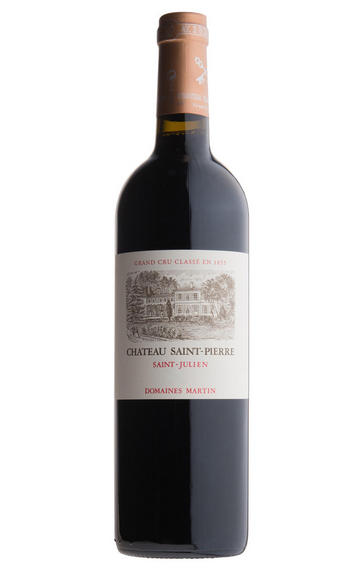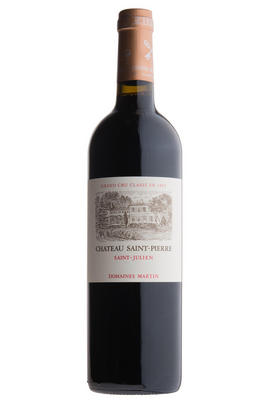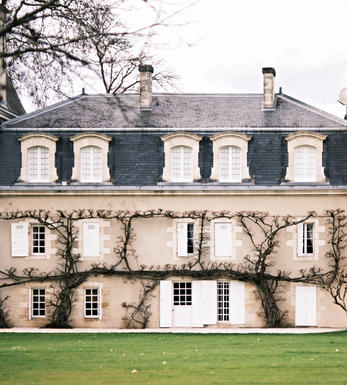
2005 Château Saint-Pierre, St Julien, Bordeaux

Critics reviews
Robert M. Parker, Jr. - 29/06/2015
About this WINE

Château Saint-Pierre
Château Saint-Pierre is the smallest Classified Growth in St Julien. It was ranked a Fourth Growth in 1855, but over the next century it was broken up into smaller and smaller parts. It was restored to its original holdings in 1982 by then-owner Henri Martin, proprietor of nearby Château Gloria. Today, his legacy lives on through his son-in-law Jean-Louis Triaud, and Jean-Louis’s own children.
The elegant château building looks rather classic, but it belies a surprisingly modern approach behind the scenes. Infrared photography of the vineyard allows the team to carefully plan out harvesting schedules to the level of the individual plant. This 17-hectare estate is undergoing organic conversion and holds HVE-3 certification. Viticulture follows a bespoke mix of techniques picked up from organics and biodynamics, which Jean-Louis calls “our own system”.
There have been advances in the winery, too. Instead of pumping-over once in the morning and once in the afternoon, there are small pump-overs at hourly intervals, working around the clock. Amphorae are already a fixture of the cellar, and Jean-Louis hopes to reach a 50-50 balance between amphorae and the more traditional new French oak barriques.

St Julien
St Julien is the smallest of the "Big Four" Médoc communes. Although, without any First Growths, St Julien is recognised to be the most consistent of the main communes, with several châteaux turning out impressive wines year after year.
St Julien itself is much more of a village than Pauillac and almost all of the notable properties lie to its south. Its most northerly château is Ch. Léoville Las Cases (whose vineyards actually adjoin those of Latour in Pauillac) but, further south, suitable vineyard land gives way to arable farming and livestock until the Margaux appellation is reached.
The soil is gravelly and finer than that of Pauillac, and without the iron content which gives Pauillac its stature. The homogeneous soils in the vineyards (which extend over a relatively small area of just over 700 hectares) give the commune a unified character.
The wines can be assessed as much by texture as flavour, and there is a sleek, wholesome character to the best. Elegance, harmony and perfect balance and weight, with hints of cassis and cedar, are what epitomise classic St Julien wines. At their very best they combine Margaux’s elegance and refinement with Pauillac’s power and substance.
Ch. Léoville Las Cases produces arguably the most sought-after St Julien, and in any reassessment of the 1855 Classification it would almost certainly warrant being elevated to First Growth status.
Recommended Châteaux: Ch. Léoville Las Cases, Ch.Léoville Barton, Ch Léoville Poyferré, Ch. Ducru-Beaucaillou, Ch Langoa Barton, Ch Gruaud Larose, Ch. Branaire-Ducru, Ch. Beychevelle

Cabernet Sauvignon Blend
Cabernet Sauvignon lends itself particularly well in blends with Merlot. This is actually the archetypal Bordeaux blend, though in different proportions in the sub-regions and sometimes topped up with Cabernet Franc, Malbec, and Petit Verdot.
In the Médoc and Graves the percentage of Cabernet Sauvignon in the blend can range from 95% (Mouton-Rothschild) to as low as 40%. It is particularly suited to the dry, warm, free- draining, gravel-rich soils and is responsible for the redolent cassis characteristics as well as the depth of colour, tannic structure and pronounced acidity of Médoc wines. However 100% Cabernet Sauvignon wines can be slightly hollow-tasting in the middle palate and Merlot with its generous, fleshy fruit flavours acts as a perfect foil by filling in this cavity.
In St-Emilion and Pomerol, the blends are Merlot dominated as Cabernet Sauvignon can struggle to ripen there - when it is included, it adds structure and body to the wine. Sassicaia is the most famous Bordeaux blend in Italy and has spawned many imitations, whereby the blend is now firmly established in the New World and particularly in California and Australia.


Buying options
Add to wishlist
Description
This may be a modest chteau (although its selection of old gnarled vines are a good sign) particularly in the context of the great names that surround it, but it is hugely underrated, as the 2005 proves. Known for its power and muscle, in 2005 it has added the communes characteristic charm, extra ripe fruit and a very long generous finish. This will surely be one of the best value wines of the vintage. Drink 2012-2025.
BBR Score: 16.5/20. Parker Score: 92-94/100.
wine at a glance
Delivery and quality guarantee